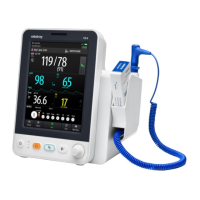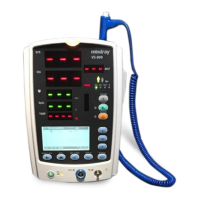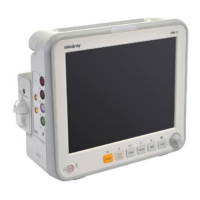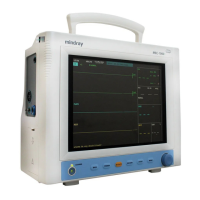7-4
7.5.3 Setting SpO
2
Sensitivity
For Mindray SpO
2
module, you can set [Sensitivity] to [High], [Med] or [Low] in the [SpO
2
Setup] menu; for Masimo SpO
2
module, you can set [Sensitivity] to [Maximum] or
[Normal] in the [SpO
2
Setup] menu.
When the sensitivity is set to [High] or [Maximum], the equipment is more sensitive to
minor signals. When monitoring critically ill patients whose pulsations are very weak, it is
strongly recommended that the sensitivity is set to [High] or [Maximum]. When
monitoring neonatal or non-critically ill patients who tend to move a lot, noise or invalid
signals may be caused. In this case, it is recommended that the sensitivity is set to [Low]
or [Normal] so that the interference caused by motion can be filtered and therefore the
measurement stability can be ensured.
7.5.4 Changing Averaging Time
The SpO
2
value displayed on the monitor screen is the average of data collected within a
specific time. The shorter the averaging time is, the quicker the equipment responds to
changes in the patient’s oxygen saturation level. Contrarily, the longer the averaging time
is, the slower the equipment responds to changes in the patient’s oxygen saturation level,
but the measurement accuracy will be improved. For critically ill patients, selecting
shorter averaging time will help understanding the patient’s state.
To set the averaging time:
For Mindray SpO
2
module, select [Sensitivity] in the [SpO
2
Setup] menu and
then toggle between [High], [Med] and [Low], which respectively correspond to
7 s, 9 s and 11 s.
For Masimo SpO
2
module, select [Averaging] in the [SpO
2
Setup] menu and then
toggle between [2-4 s], [4-6 s], [8 s], [10 s], [12 s], [14 s] and [16 s].
7.5.5 Monitoring SpO
2
and NIBP Simultaneously
When monitoring SpO
2
and NIBP on the same limb simultaneously, you can switch [NIBP
Simultaneous] on in the [SpO
2
Setup] menu to lock the SpO
2
alarm status until the NIBP
measurement ends. If you switch [NIBP Simultaneous] off, low perfusion caused by NIBP
measurement may lead to inaccurate SpO
2
readings and therefore cause false
physiological alarms.
7.5.6 Sat-Seconds Alarm Management
With traditional alarm management, high and low alarm limits are set for monitoring
oxygen saturation. During monitoring, as soon as an alarm limit is violated, an audible
alarm immediately sounds. When the patient % SpO
2
fluctuates near an alarm limit, the
alarm sounds each time the limit is violated. Such frequent alarm can be distracting.
Nellcor’s Sat-Seconds alarm management technique is used to reduce these nuisance
alarms.
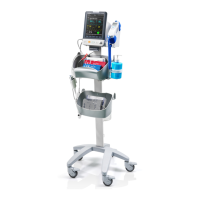
